July 23, 2019 feature
Topology optimization and 3-D printing multimaterial magnetic actuators and displays
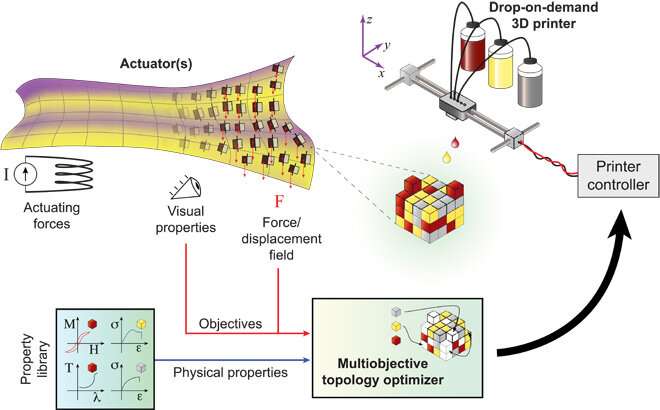
In materials science and applied physics, researchers expect actuation systems to perform similarly to natural phenomena. As a classic example, scientists proposed to engineer bioinspired materials that mimicked the camouflage of cuttlefish, although engineering such highly integrated systems can be challenging due to the combined complexity of generating high-dimensional architectural designs and multifunctional materials associated with their fabrication process. In a recent report on Science Advances, Subramanian Sundaram and colleagues in the departments of computer science, artificial intelligence and electrical engineering in the U.S. and France presented a complete protocol on multi-objective topology optimization and multimaterial drop-on-demand three-dimensional (3-D) printing to engineer complex actuators.
The actuators contained soft and rigid polymers coupled to a magnetic nanoparticle/polymer composite that responded to a magnetic field. The topology optimizer could assign materials for individual voxels to enhance the high-resolution physical appearance. When they unified the topology optimized design strategy with the multimaterial fabrication process, Sundaram et al. could engineer complex actuators as a promising route towards automated and goal-driven fabrication.
Modern robots require actuators that integrate multiple functions together inside a single package for optimized height, power efficiency, topology, size and other performance metrics. This idea underlies research proposals that advocate for the tight integration of sensing, actuation and computation with robotic materials. Researchers still debate if robots will be bodies with brains or brains with bodies and therefore a distinction between materials and machines remains to be established. The new paradigm with robotic materials require robot parts to be designed for multiple functions and optimized for multiple objectives as with natural organisms.
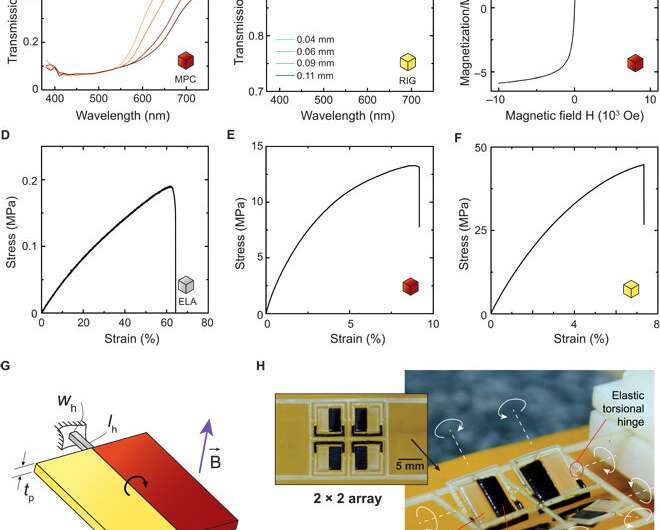
The challenge with reproducing bioinspired multifunctional systems remains on the design of actuation systems. In the classic example of an actuation system of a cuttlefish, the simultaneous control of both physical deflections and high-resolution appearance results in effective biological camouflage. Reproducing such seamlessly integrated actuation in the lab is cumbersome due to the complexity in creating a high-dimensional design space and fabricating these designs with new materials and free-form geometries.
In contemporary examples of actuation systems, materials scientists have developed a digital micromirror device with millions of identical actuators and a 'millipede' high-density data storage system with microelectromechanical system cantilevers. Optimizing these actuation systems for power consumption, low footprint and process reliability are time consuming, while nonuniform actuator arrays presented additional complexity in the lab. As a promising alternative, topology optimization techniques offer automatically optimized material layouts in a given design space.
In the present work, Sundaram et al. used a simulated annealing strategy previously used as a successful topology optimization approach to design truss structures. While very generic in theory, the approach accounted specificities of the problem to be effective in practice. In the present approach, Sundaram et al. considered the role of the materials, where the technique was fully fabrication aware. The proposed study on a high resolution, multiphysics and fabrication-aware topology optimization framework is a first strategy implemented in the present work.
The scientists used a precision manufacturing process capable of handling high-dimensional designs to fabricate the synthetic actuator. Thereafter, they chose a rapid additive 3-D manufacturing approach for actuator fabrication to produce precise, complex structures with diverse materials. The rising interest in 3-D printed actuators is due to their speed and applicability in micro-/mesoscale robotics.
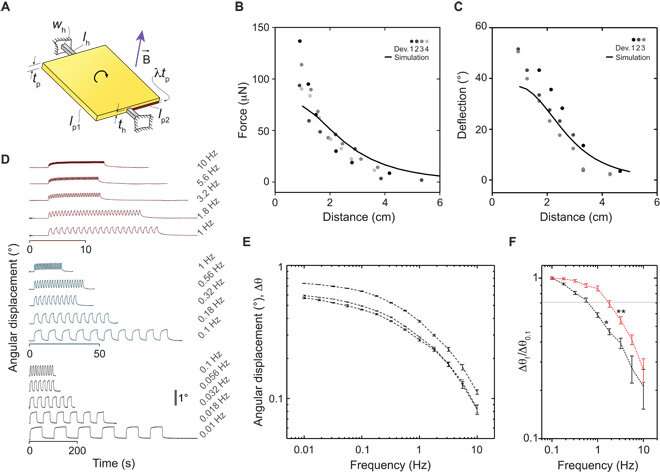
Scientists had previously explored the property of magnetic actuation for soft matter due to favorable scaling, high actuating force density and untethered actuation. Sundaram et al. unified a biomimetic evolutionary optimization technique with an automated multimaterial additive manufacturing process to rapidly design and fabricate high-dimensional actuators in the present work. The approach could eventually allow fully automated fabrication of high-dimensional designs, which is a long-term goal in robotics.
The researchers implemented the custom drop-on-demand 3-D printing process to optimize the entire fabrication pipeline and perform fabrication-aware improvements. They designed a specific actuator in a planar, rigid structure with synthetic cells filled in with a transparent rigid polymer or a dark magnetically responsive polymer. The topology optimizer controlled the placement of the two materials relative to their material properties for optimal applications. Sundaram et al. then combined a custom multimaterial drop-on-demand 3-D printing process with multi-objective topology optimization to engineer the high-dimensional actuator designs in the lab. They created a set of ultraviolet (UV)-curable inks with a variety of effects to include optical, magnetic and mechanical properties, then characterized the samples to generate a property library.
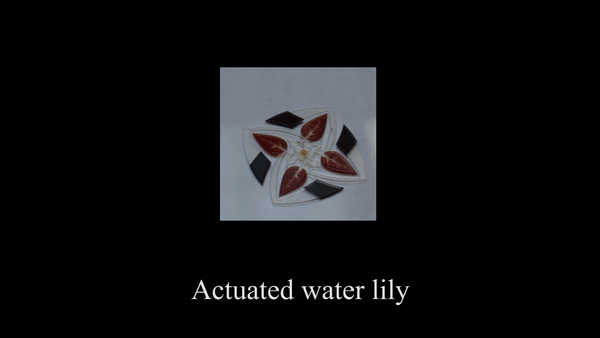
The scientists used a custom-built ink-jet based multimaterial 3-D printer. They used a rigid acrylate polymer (RIG), an elastic acrylate polymer (ELA) and a magnetic nanoparticle polymer composite (MPC) alongside optimized starting inks for the inkjet printing process. After ink deposition, they used a UV-light-emitting diode (LED) array to crosslink the ink via free-radical photopolymerization. The three materials contained widely varying elastic moduli and material properties allowing them to make soft joints and rigid structures for use as actuators. The scientists demonstrated their capabilities and fabricated a variety of multimaterial actuator arrays as manually designed. They cycled the designed and engineered actuators for at least 1000 cycles without performance degradation.
Sundaram et al. investigated the applications of 3-D printed multimaterial-based soft magnetic actuators using an electromagnet powered by a current source to generate a tunable magnetic field. As a proof-of-concept, they developed four individual petals for magnetic actuation on an air-water interface, where the petals surfaced from the water interface. For repeatable actuation, they placed the printed samples at a silicone oil-water interface. These manually designed examples were a first to highlight multimaterial additive fabrication coupled with magnetic actuation. The strategy seamlessly integrated multimaterial printing and topology optimization to demonstrate unique, high-resolution optical properties.
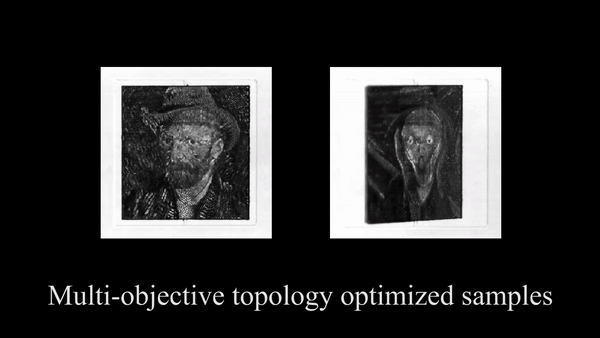
The scientists optimized multi-objective topology using simulation software to understand the distribution of the MPC (Magnetic nanoparticle polymer composite) cells for magnetic actuation. They then applied the method to two different images of paintings that included a self-portrait by Van Gogh and the "Scream" by Munch. After applying the topology optimization framework, they controlled magnetic actuation with an applied magnetic field to gradually transition images from the Van Gogh to the Munch portrait by increasing the tilt/deflection angles. The scientists then characterized the topology-optimized actuator with long-term tests.
In this way, Subramanian Sundaram and colleagues developed a topology optimizer to match the target's optical properties and its tilting angles. The scientists additionally coupled a drop-on-demand inkjet-based 3-D printing with the optimization technique to engineer topology-optimized designs and generate high-resolution optical properties. Although challenges exist in the development of new inks and materials, they could fabricate a wide-range of materials using the process.
The researchers can design the entire fabrication pipeline for enhanced freedom of control with fabrication-aware optimization. The topology-optimized actuator and the accompanying fabrication toolkit can be used to design actuators with sensors and basic computing elements to accomplish the long-held vision of multifunctional robotic/autonomic composites with large-scale integration and self-sufficiency. When scientists further explore these foundational strategies, they will be able to form multifunctional actuators with minimal human intervention.
More information: Subramanian Sundaram et al. Topology optimization and 3-D printing of multimaterial magnetic actuators and displays, Science Advances (2019). DOI: 10.1126/sciadv.aaw1160
M. A. McEvoy et al. Materials that couple sensing, actuation, computation, and communication, Science (2015). DOI: 10.1126/science.1261689
Yiğit Mengüç et al. Will robots be bodies with brains or brains with bodies?, Science Robotics (2017). DOI: 10.1126/scirobotics.aar4527
Subramanian Sundaram et al. 3-D-Printed Self-Folding Electronics, ACS Applied Materials & Interfaces (2017). DOI: 10.1021/acsami.7b10443
© 2019 Science X Network



















